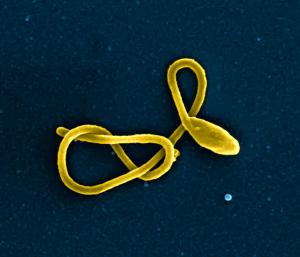Broadly acting antibodies found in plasma of Ebola survivors
Recent Ebola virus disease (EVD) outbreaks, including the 2013-2016 epidemic that ravaged West Africa and the 2018 outbreak in the Democratic Republic of the Congo, highlight the need for licensed treatments for this often-deadly disease. ZMapp, an experimental therapy comprising three monoclonal antibodies, has shown promise in a clinical trial, but it targets only one of the five known species of Ebola virus. Now, scientists supported by the National Institute of Allergy and Infectious Diseases (NIAID), part of the National Institutes of Health, have discovered a set of powerful, broadly neutralizing antibodies (bNAbs) in the blood of EVD survivors. In animal studies, two of these antibodies provided substantial protection against disease caused by Zaire ebolavirus, Bundibugyo ebolavirus and Sudan ebolavirus, the three species known to cause fatal human illness.

Colorized scanning electron micrograph of a single filamentous Ebola virus particle.
James E. Crowe, Jr., M.D., of Vanderbilt University Medical Center, Nashville, and Alexander Bukreyev, Ph.D., of University of Texas Medical Branch, Galveston, headed the research team. The investigators analyzed blood plasma from 17 people who had recovered from EVD. Antibodies isolated from two survivors bound to an essential virus protein, called glycoprotein or GP, from Zaire, Bundibugyo and Sudan Ebola virus species, and prevented the viruses from entering host cells.
Ebola virus uses GP to attach to cell membranes and initiate infection. In a series of experiments, the team delineated interactions between various forms of viral GP and three of the newly isolated bNAbs. The results provided evidence of multiple mechanisms by which the antibodies inhibit actions of all forms of GP, thus preventing infection by halting viral entry into the host cell. The team also determined that one of the bNAbs, EBOV-520, recognizes and binds to a portion of virus GP in such a way that prevents it from interacting with a cell surface protein called NPC1 and initiating the infection cycle.
Source: U.S. National Institutes of Health
- 262 reads
Human Rights
Ringing FOWPAL’s Peace Bell for the World:Nobel Peace Prize Laureates’ Visions and Actions

Protecting the World’s Cultural Diversity for a Sustainable Future

The Peace Bell Resonates at the 27th Eurasian Economic Summit

Declaration of World Day of the Power of Hope Endorsed by People in 158 Nations

Puppet Show I International Friendship Day 2020

